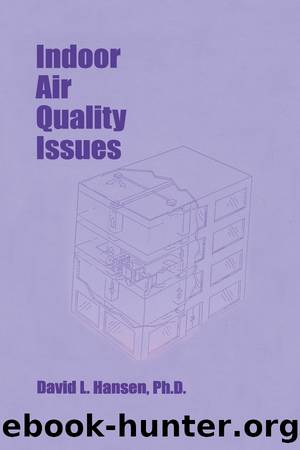Indoor Air Quality Issues by David L. Hansen

Author:David L. Hansen
Language: eng
Format: epub
ISBN: 9781351438919
Publisher: CRC Press
Allergic Diseases
The function of the immune system is to recognize âforeignâ proteins (called antigens) and to form antibodies (also called immunoglobulin), as part of the bodyâs defense against infection and disease (Clayman 1989). Microorganisms and/or their by-products can act as antigens and cause various allergic reactions. Allergies are inappropriate or exaggerated reactions of the immune system to foreign proteins, which may not actually be harmful; these reactions are termed hypersensitivity reactions.
Allergic reactions do not occur during the first exposure to an antigen. Rather, they occur only on the second or subsequent exposures to the biomatter, after the first contact has sensitized the body (Clayman 1989). During the first exposure, the antigens (in this case microbial material) provoke the immune system to produce specific antibodies, namely, immunoglobulin E or G. These antibodies coat the mast cells present in the stomach, lungs, and upper respiratory airways. At this first exposure, the person may not experience any ill effects, but when the antigen is encountered again, it binds to the antibodies and causes the mast cells to release chemicals that produce the allergic response (Clayman 1989). Allergic responses to aerosolized microbial matter include hypersensitivity pneumonitis, asthma, and rhinitis (hay fever) as well as mucous membrane irritation and chronic bronchitis.
Hypersensitivity pneumonitis (HP) causes fever, chills, and cough 8 to 12 hours after exposure. These symptoms disappear after one or two days but reappear after another exposure. Once an individual develops a sensitization of the respiratory tract, continued exposure to the antigen can lead to permanent disease. However, it is unclear how long the latency period is between exposure and onset of symptoms. Both atopic (a predisposition to various allergic reactions) and nonatopic occupants can get HP from exposure to specific organisms. There are numerous case studies of building-related HP outbreaks due to exposure and subsequent sensitization to microbial aerosols (Rose 1996).
In the United States alone it is estimated that more than 10 million people suffer from asthma. There are two main types of asthma: extrinsic, in which an allergy to an external factor triggers an attack, and intrinsic, in which there is no apparent external cause (Clayman 1989). The main symptoms are breathlessness, wheezing, a dry cough, and a feeling of tightness in the chest.
Allergic asthma and rhinitis (hay fever) can be caused by airborne fungus spores (ASHRAE 1989). But it is difficult to ascertain if a building-related source of microbial matter is in fact causing the asthma, because numerous other factors such as chemical irritants and cold air can induce asthma.
Download
This site does not store any files on its server. We only index and link to content provided by other sites. Please contact the content providers to delete copyright contents if any and email us, we'll remove relevant links or contents immediately.
| Automotive | Engineering |
| Transportation |
Whiskies Galore by Ian Buxton(41653)
Introduction to Aircraft Design (Cambridge Aerospace Series) by John P. Fielding(32969)
Small Unmanned Fixed-wing Aircraft Design by Andrew J. Keane Andras Sobester James P. Scanlan & András Sóbester & James P. Scanlan(32639)
Craft Beer for the Homebrewer by Michael Agnew(18026)
Turbulence by E. J. Noyes(7834)
The Complete Stick Figure Physics Tutorials by Allen Sarah(7214)
Kaplan MCAT General Chemistry Review by Kaplan(6738)
The Thirst by Nesbo Jo(6650)
Bad Blood by John Carreyrou(6401)
Modelling of Convective Heat and Mass Transfer in Rotating Flows by Igor V. Shevchuk(6301)
Learning SQL by Alan Beaulieu(6114)
Weapons of Math Destruction by Cathy O'Neil(6000)
Man-made Catastrophes and Risk Information Concealment by Dmitry Chernov & Didier Sornette(5808)
Digital Minimalism by Cal Newport;(5517)
Life 3.0: Being Human in the Age of Artificial Intelligence by Tegmark Max(5319)
iGen by Jean M. Twenge(5255)
Secrets of Antigravity Propulsion: Tesla, UFOs, and Classified Aerospace Technology by Ph.D. Paul A. Laviolette(5174)
Design of Trajectory Optimization Approach for Space Maneuver Vehicle Skip Entry Problems by Runqi Chai & Al Savvaris & Antonios Tsourdos & Senchun Chai(4911)
Electronic Devices & Circuits by Jacob Millman & Christos C. Halkias(4820)
